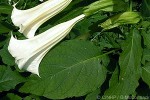Cook Islands Biodiversity Database
Species Page
Brugmansia suaveolens
Angel's-Trumpet
Multimedia & Additional Resources
| Type | Description | Download |
| Leaves and flowers | 87KB |
General Information
Cook Islands Distribution
| Southern Group: Present Makatea: Present | ||||||||
RR |
MG |
AT |
MK |
MT |
AK |
PL |
TK |
MN |
++ |
+ |
- |
- |
- |
- |
|||
| Northern Group: | |||||
TN |
MH |
RK |
PK |
NS |
SW |
- |
- |
- |
- |
- |
- |
Scientific Taxonomy
Brugmansia suaveolens (Hump. & Bonpl. ex Willd.)
SYNONYMS: Datura suaveolens; Datura arborea [sensu GW]
TAXONOMY: PLANTAE; ANTHOPHYTA (=Angiospermae); MAGNOLIOPSIDA (=Dicotyledones); ASTERIDAE; Solanales; SOLANACEAE
More Information
SIGNIFICANCE NOTES -
POSITIVE SIGNIFICANCE: Ornamental flowers
NEGATIVE SIGNIFICANCE: Poisonous - very serious. Comments: All parts very toxic - see General Note. Mild invasive spreading vegetatively (as in upper Avatiu Valley)
GENERAL NOTE: All parts Brugmansia spp. and Datura spp. are dangerously toxic able to cause extreme hallucinations, delirium and death. The active ingredients are the primary tropane alkaloids scopolamine, atropine and hyoscyamine. These chemicals are fat soluble and readily absorbed through the mucous membranes and even through the skin. Handle with extreme care.
The Louisiana Poison Control Center [www.lapcc.org] says in severe cases the "patient exhibits all of the classic findings of anticholinergic poisoning: Red as a Beet; Hot as a Hare; Blind as a Bat; Dry as a Bone; and Mad as a Hatter. Although frequently mistaken for cocaine or amphetamine overdose, the absolute lack of sweating and the very large, dilated pupils are always present. Tachycardia and urinary retention are also very common findings (Fast as a Cat and Full as a Tick). Besides general supportive care, physostigmine is the treatment of choice for severe anticholinergic poisoning as seen with ingestion of these plants or large antihistamine overdoses."
Vouchers & References
Vouchers:
None Recorded.
References:
p.749 Neal - In Gardens of Hawaii
p.185 Hortus 3rd
p.171 Royal Hort. Soc. Index of Garden Plants
p.893 Tropica
p.5/033 A.C.Smith - Flora Vitiensis Nova
p.95 RC Wilder - Flora of Rarotonga
Data Update History (information):
zTX, zB02, zM02, zupM03b, zD02, zupD05b
Web Resources
Citation Information
McCormack, Gerald (2007) Cook Islands Biodiversity Database, Version 2007.2. Cook Islands Natural Heritage Trust, Rarotonga. Online at http://cookislands.bishopmuseum.org. ![]()
Please refer to our use policy.

